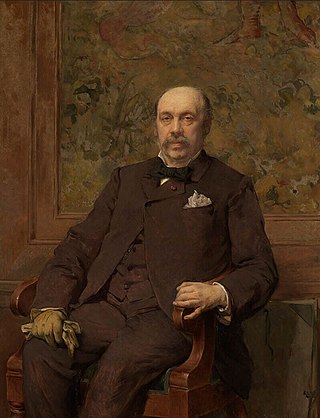Following is a list of Belgian architects in alphabetical order.
Following is a list of Belgian architects in alphabetical order.

The Prix de Rome or Grand Prix de Rome was a French scholarship for arts students, initially for painters and sculptors, that was established in 1663 during the reign of Louis XIV of France. Winners were awarded a bursary that allowed them to stay in Rome for three to five years at the expense of the state. The prize was extended to architecture in 1720, music in 1803 and engraving in 1804. The prestigious award was abolished in 1968 by André Malraux, then Minister of Culture, following the May 68 riots that called for cultural change.

Ghent University is a public research university located in Ghent, Belgium.

Victor Pierre Horta was a Belgian architect and designer, and one of the founders of the Art Nouveau movement. He was a fervent admirer of the French architectural theorist Eugène Viollet-le-Duc and his Hôtel Tassel in Brussels (1892–93), often considered the first Art Nouveau house, is based on the work of Viollet-le-Duc. The curving stylized vegetal forms that Horta used in turn influenced many others, including the French architect Hector Guimard, who used it in the first Art Nouveau apartment building he designed in Paris and in the entrances he designed for the Paris Metro. He is also considered a precursor of modern architecture for his open floor plans and his innovative use of iron, steel and glass.

Théophile "Théo" van Rysselberghe was a Belgian neo-impressionist painter, who played a pivotal role in the European art scene at the turn of the twentieth century.

Jean-François Portaels or Jan Portaels was a Belgian painter of genre scenes, biblical stories, landscapes, portraits and orientalist subjects. He was also a teacher and director of the Academy of Fine Arts of Ghent and the Académie Royale des Beaux-Arts in Brussels. He is regarded as the founder of the Belgian Orientalist school. He was praised in his time as the premier painter of 'everyday elegance and feminine grace'. Through his art, teaching and his leadership of the Académie Royale in Brussels he exerted an important influence on the next generation of Belgian artists, including his pupil Théo van Rysselberghe.

The Royal Academy of Fine Arts of Brussels is an art school established in Brussels, Belgium. It was founded in 1711. Starting from modest beginnings in a single room in Brussels' Town Hall, it has since 1876 been operating from a former convent and orphanage in the Rue du Midi/Zuidstraat, which was converted by the architect Victor Jamaer. The school has played an important role in training leading local artists.
The minister of justice of Belgium is responsible for the Federal Public Service Justice.

Johan Neerman is a Belgian architect, industrial designer and systems thinker. He works with naval architecture, appropriate technology, transport design, cultural concepts and arts, systems thinking.
Events in the year 1894 in Belgium.
The Cluysenaar is a Belgian family notably of architects and artists.
Events in the year 1895 in Belgium.
Events in the year 1891 in Belgium.

The Art Deco movement of architecture and design appeared in Brussels, Belgium, immediately after World War I when the famed architect Victor Horta began designing the Centre for Fine Arts, and continued until the beginning of World War II in 1939. It took its name from the International Exposition of Modern Decorative and Industrial Arts held in Paris in 1925. At the end of World War II, Art Deco in Brussels faded to make way for the modernist and international architectural styles that would mark the postwar period.

Octave van Rysselberghe was a Belgian architect of the Art Nouveau period. He is one of the representatives of the architectural renewal that characterized the end of the 19th century, with Victor Horta, Paul Hankar and Henry Van de Velde.

The Van Rysselberghe family is a Belgian family, originating in Ghent, which produced a number of artists and intellectuals. Jean-Baptist van Rysselberghe was a carpenter and entrepreneur who established himself in Ghent. He had six children, five of whom became prominent artists and scientists. The most distinguished member of the family was neo-impressionist painter Théo van Rysselberghe, Jean-Baptist's youngest son. Members of the family have included: